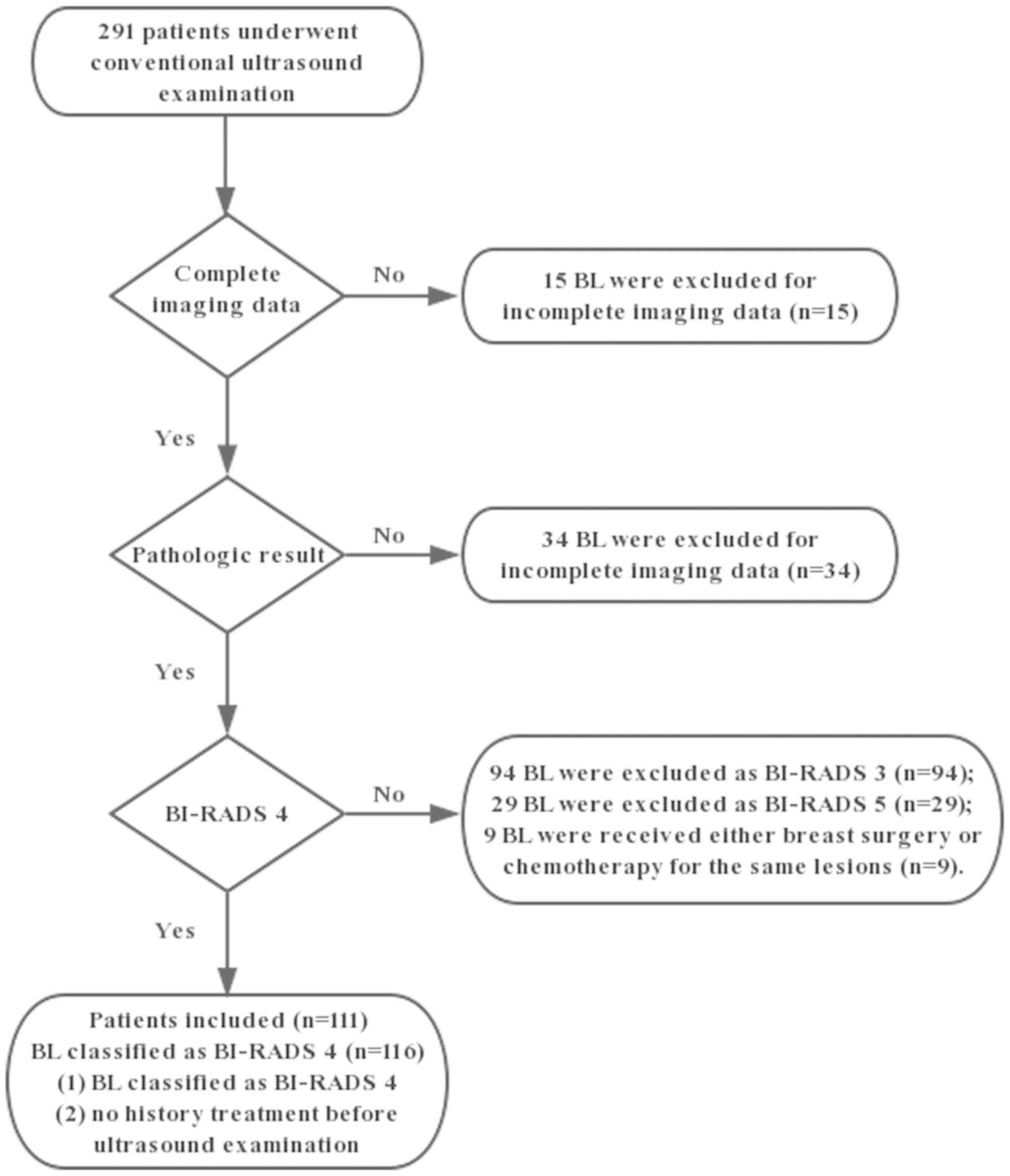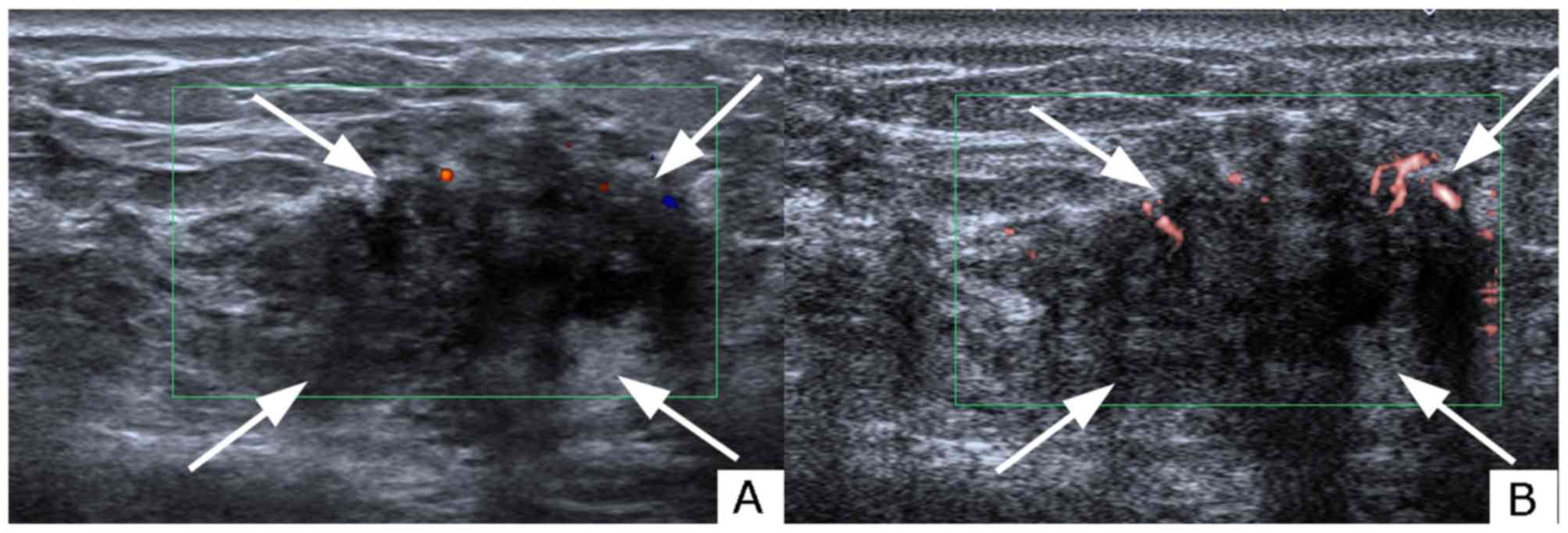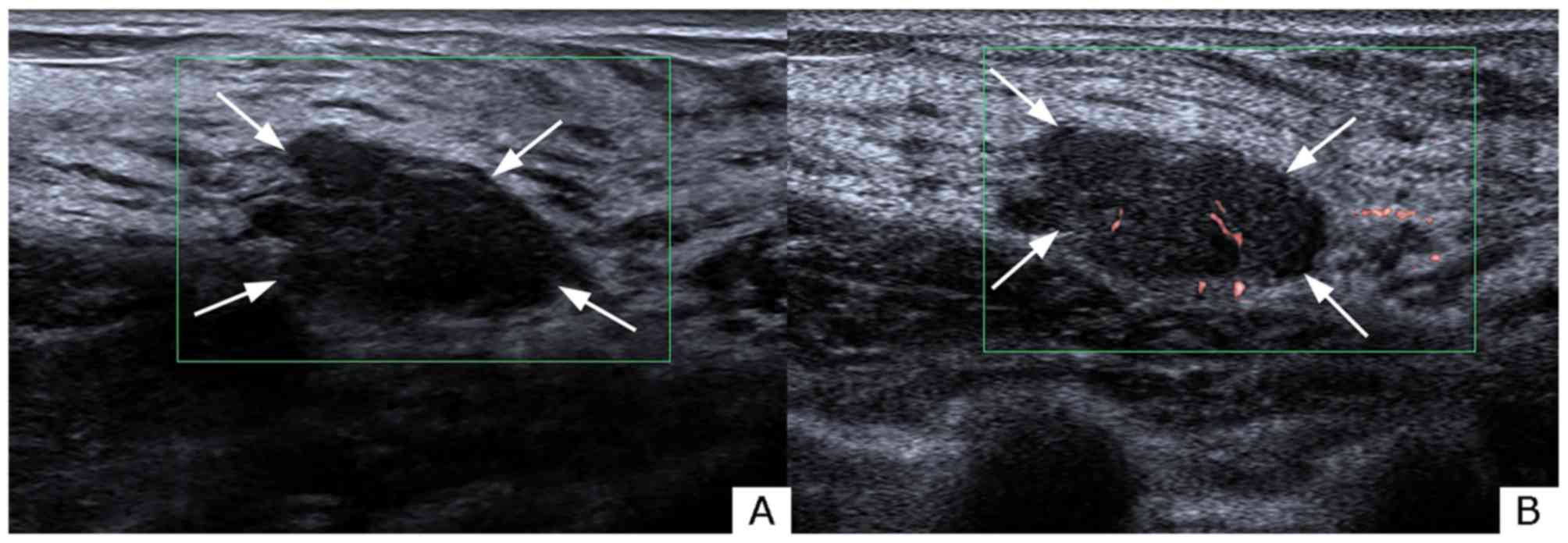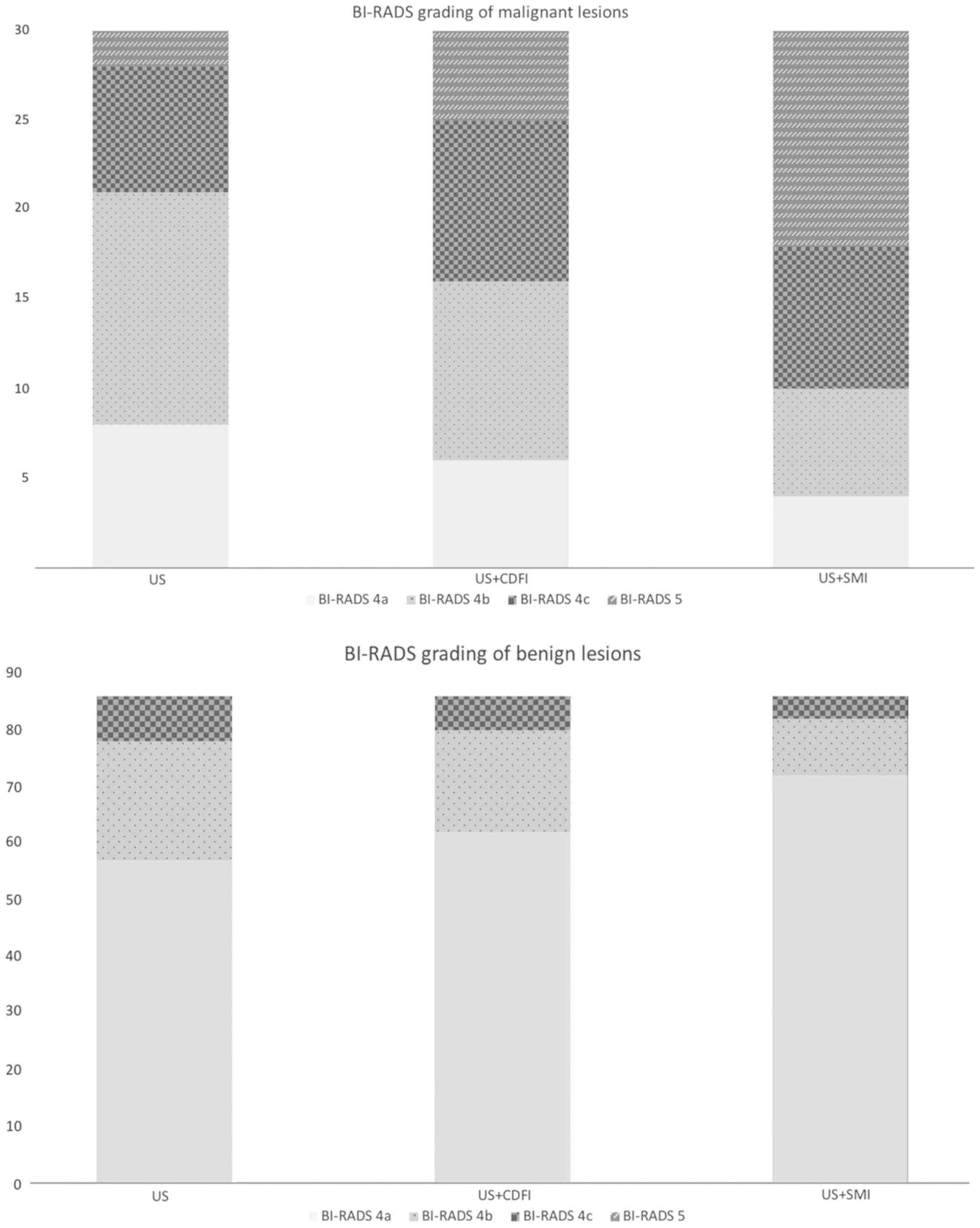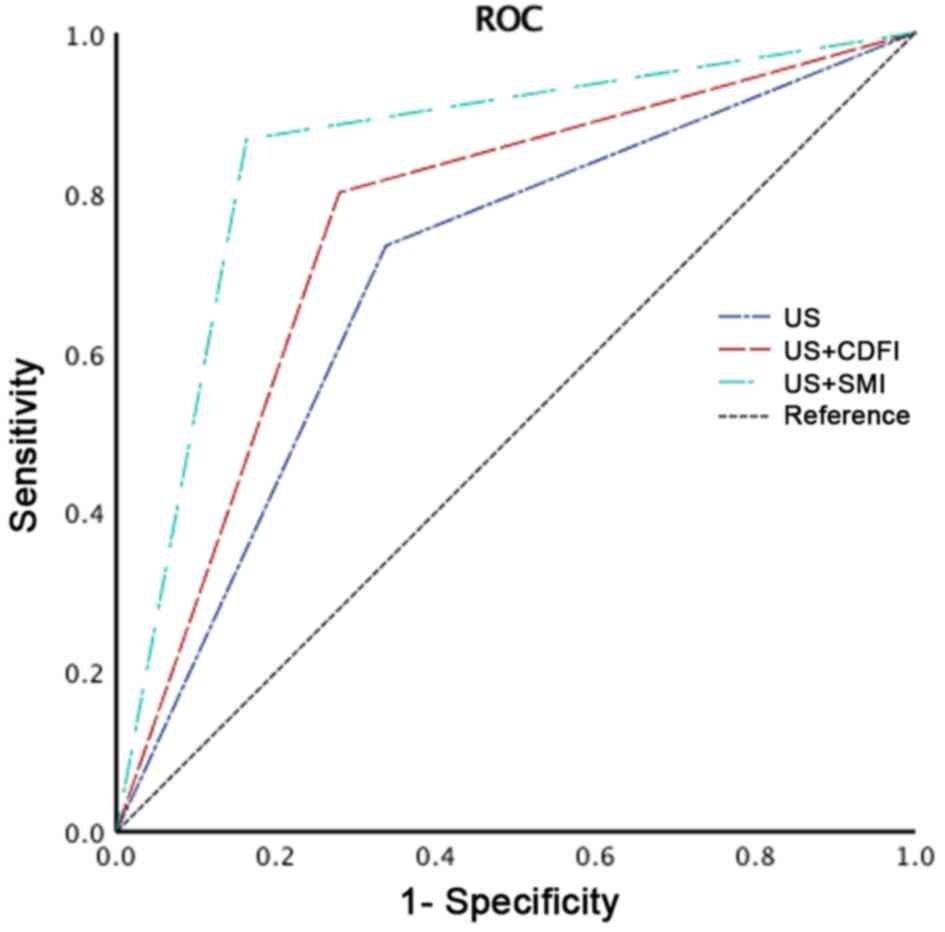|
1
|
Li T, Mello-Thoms C and Brennan PC:
Descriptive epidemiology of breast cancer in China: Incidence,
mortality, survival and prevalence. Breast Cancer Res Treat.
159:395–406. 2016. View Article : Google Scholar : PubMed/NCBI
|
|
2
|
Rezaee A, Buck A, Raderer M, Langsteger W
and Beheshti M: Chapter 3-breast cancer BT-PET/CT in cancer: An
interdisciplinary approach to individualized imaging. Elsevier.
43–63. 2018.
|
|
3
|
Folkman J: Angiogenesis in cancer,
vascular, rheumatoid and other disease. Nat Med. 1:27–31. 1995.
View Article : Google Scholar : PubMed/NCBI
|
|
4
|
Stratman AN, Yu JA, Mulligan TS, Butler
MG, Sause ET and Weinstein BM: Chapter 24-blood vessel formation,
editor(s): Sally a. Moody, Principels of developmental genetics
(Second edition). Academic Press; pp. 421–449. 2015
|
|
5
|
Lee SH, Chung J, Choi HY, Choi SH, Ryu EB,
Ko KH, Koo HR, Park JS, Yi A, Youk JH, et al: Evaluation of
screening US-detected breast masses by combined use of elastography
and color doppler US with B-mode US in women with dense breasts: A
multicenter prospective study. Radiology. 285:660–669. 2017.
View Article : Google Scholar : PubMed/NCBI
|
|
6
|
Kook SH, Park HW, Lee YR, Lee YU, Pae WK
and Park YL: Evaluation of solid breast lesions with power Doppler
sonography. J Clin Ultrasound. 27:231–237. 1999. View Article : Google Scholar : PubMed/NCBI
|
|
7
|
Park AY, Seo BK, Woo OH, Jung KS, Cho KR,
Park EK, Cha SH and Cha J: The utility of ultrasound superb
microvascular imaging for evaluation of breast tumour vascularity:
Comparison with colour and power Doppler imaging regarding
diagnostic performance. Clin Radiol. 73:304–311. 2018. View Article : Google Scholar : PubMed/NCBI
|
|
8
|
Zhu YC, Zhang Y, Deng SH and Jiang Q: A
prospective study to compare superb microvascular imaging with
grayscale ultrasound and color doppler flow imaging of vascular
distribution and morphology in Thyroid nodules. Med Sci Monit.
24:9223–9231. 2018. View Article : Google Scholar : PubMed/NCBI
|
|
9
|
Dubinsky TJ, Revels J, Wang S, Toia G,
Sonneborn R, Hippe DS and Erpelding T: Comparison of Superb
Microvascular Imaging with color flow and power doppler imaging of
small hepatocellular carcinomas. J Ultrasound Med. 37:2915–2924.
2018. View Article : Google Scholar : PubMed/NCBI
|
|
10
|
He MN, Lv K, Jiang YX and Jiang TA:
Application of superb microvascular imaging in focal liver lesions.
World J Gastroenterol. 23:7765–7775. 2017. View Article : Google Scholar : PubMed/NCBI
|
|
11
|
Mercado CL: BI-RADS update. Radiol Clin
North Am. 52:481–487. 2014. View Article : Google Scholar : PubMed/NCBI
|
|
12
|
Levy L, Suissa M, Chiche JF, Teman G and
Martin B: BIRADS ultrasonography. Eur J Radiol. 61:202–211. 2007.
View Article : Google Scholar : PubMed/NCBI
|
|
13
|
Strigel RM, Burnside ES, Elezaby M, Fowler
AM, Kelcz F, Salkowski LR and DeMartini WB: Utility of BI-RADS
assessment category 4 subdivisions for screening breast MRI. AJR Am
J Roentgenol. 208:1392–1399. 2017. View Article : Google Scholar : PubMed/NCBI
|
|
14
|
Raza S, Goldkamp AL, Chikarmane SA and
Birdwell RL: US of breast masses categorized as BI-RADS 3, 4, and
5: Pictorial review of factors influencing clinical management.
Radiographics. 30:1199–1213. 2010. View Article : Google Scholar : PubMed/NCBI
|
|
15
|
Adler DD, Carson PL, Rubin JM and
Quinn-Reid D: Doppler ultrasound color flow imaging in the study of
breast cancer: Preliminary findings. Ultrasound Med Biol.
16:553–559. 1990. View Article : Google Scholar : PubMed/NCBI
|
|
16
|
Durand MA and Hooley RJ: Implementation of
whole-breast screening ultrasonography. Radiol Clin North Am.
55:527–539. 2017. View Article : Google Scholar : PubMed/NCBI
|
|
17
|
Niell BL, Freer PE, Weinfurtner RJ, Arleo
EK and Drukteinis JS: Screening for breast cancer. Radiol Clin
North Am. 55:1145–1162. 2017. View Article : Google Scholar : PubMed/NCBI
|
|
18
|
Thomas L and Szabo: Chapter 11-Doppler
modes in diagnostic ultrasound imaging: Inside out (Second
edition). Academic Press; pp. 431–500. 2014
|
|
19
|
Lu R, Meng Y, Zhang Y, Zhao W, Wang X, Jin
M and Guo R: Superb microvascular imaging (SMI) compared with
conventional ultrasound for evaluating thyroid nodules. BMC Med
Imaging. 17:652017. View Article : Google Scholar : PubMed/NCBI
|
|
20
|
Durmaz MS and Sivri M: Comparison of
superb micro-vascular imaging (SMI) and conventional Doppler
imaging techniques for evaluating testicular blood flow. J Med
Ultrason. 45:443–452. 2001. View Article : Google Scholar
|
|
21
|
Lee DH, Lee JY and Han JK: Superb
microvascular imaging technology for ultrasound examinations:
Initial experiences for hepatic tumors. Eur J Radiol. 85:2090–2095.
2016. View Article : Google Scholar : PubMed/NCBI
|
|
22
|
Ma Y, Li G, Li J and Ren WD: The
diagnostic value of superb microvascular imaging (SMI) in detecting
blood flow signals of breast lesions: A preliminary study comparing
SMI to color doppler flow imaging. Medicine (Baltimore).
94:e15022015. View Article : Google Scholar : PubMed/NCBI
|
|
23
|
Zhu YC, Zhang Y, Deng SH and Jiang Q:
Diagnostic performance of superb microvascular imaging (SMI)
combined with shear-Wave elastography in evaluating breast lesions.
Med Sci Monit. 24:5935–5942. 2018. View Article : Google Scholar : PubMed/NCBI
|
|
24
|
Less JR, Skalak TC, Sevick EM and Jain RK:
Microvascular architecture in a mammary carcinoma: Branching
patterns and vessel dimensions. Cancer Res. 51:265–273.
1991.PubMed/NCBI
|
|
25
|
Williams RG: The vascularity of normal and
neoplastic grafts in vivo. Cancer Res. 11:139–144. 1951.PubMed/NCBI
|
|
26
|
Kopeć M and Abramczyk H: Angiogenesis-a
crucial step in breast cancer growth, progression and dissemination
by Raman imaging. Spectrochim Acta Part A Mol Biomol Spectrosc.
198:338–345. 2018. View Article : Google Scholar
|
|
27
|
Raza S and Baum JK: Solid breast lesions:
Evaluation with power Doppler US. Radiology. 203:164–168. 1997.
View Article : Google Scholar : PubMed/NCBI
|
|
28
|
Xiao XY, Chen X, Guan XF, Wu H, Qin W and
Luo BM: Superb microvascular imaging in diagnosis of breast
lesions: A comparative study with contrast-enhanced
ultrasonographic microvascular imaging. Br J Radiol.
89:201605452016. View Article : Google Scholar
|
|
29
|
Zhan J, Diao XH, Jin JM, Chen L and Chen
Y: Superb microvascular imaging-A new vascular detecting
ultrasonographic technique for avascular breast masses: A
preliminary study. Eur J Radiol. 85:915–921. 2016. View Article : Google Scholar : PubMed/NCBI
|
|
30
|
Yen PL, Wu HK, Tseng HS, Kuo SJ, Huang YL,
Chen HT and Chen DR: Vascular morphologic information of
three-dimensional power Doppler ultrasound is valuable in the
classification of breast lesions. Clin Imaging. 36:267–271. 2012.
View Article : Google Scholar : PubMed/NCBI
|



